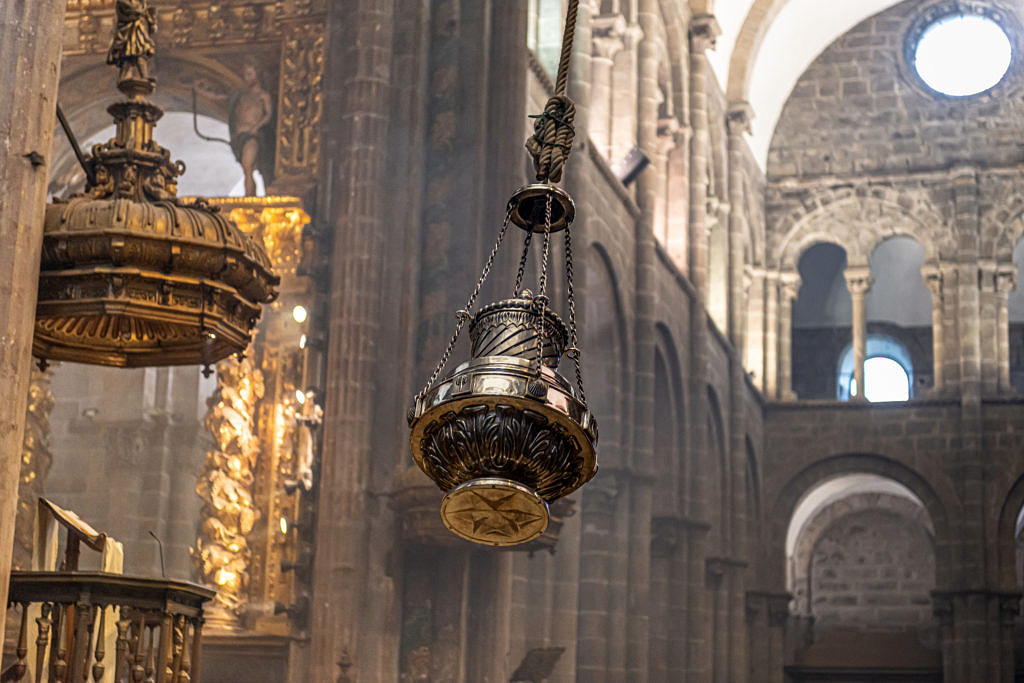Travel for travel’s sake
Ever since entertainer Hape Kerkeling published his book ‘I’m off then’ in Germany in 2006, pilgrimage has become something of a trend among his fellow countrymen. One of the most popular routes is the Way of St James, often referred to as the Camino de Santiago. Although this journey to the resting place of St. James was a major route for pilgrims as long ago as Medieval times, it became rather neglected in the early modern period, before experiencing a renaissance in the 1980s. More and more people of all nationalities – in 2019 it was 344,828 precisely – have since decided to visit the pilgrimage capital of Santiago di Compostela, many of them travelling hundreds of kilometres on foot to do so.

Why are so many people once more attracted to this long pilgrim’s way? Prof. Dr. Klaus Herbers, senior professor at the Chair of Medieval History at FAU, knows that the reasons motivating them are sometimes very different from those driving pilgrims in previous centuries. He believes that nowadays, many people are looking for a way to escape from the stress generated by their hectic lifestyle. They set out on this long journey to shake off everything in their lives that is weighing them down or threatening to suffocate them, to cast off their burdens and (re)discover the genuine priorities in their lives. In other words, a journey of self-discovery. ‘Nowadays, pilgrimage is less of a religious and more of a sociological or psychological phenomenon,’ Herbers notes. He believes people are looking for a way to slow down.
The actual destination of the pilgrimage, the cathedral in Santiago, seems to have taken a back seat for some of the modern pilgrims. For them, it’s the journey and not the destination that counts. ‘This focus on the journey itself is a modern phenomenon,’ says Herbers. In the Christian pilgrimage tradition of Medieval times, the opposite was the case: the destination was what counted. People set out for holy destinations in order to attain holy guidance, salvation and redemption for themselves and their loved ones. Christians believed that at these holy places they would be a little closer to heaven and to God himself. Many of them went seeking a miracle cure or simply hoped that their prayers, even those concerning decidedly secular matters, would be heard better at such a holy place.
The pilgrimage to Santiago was not for the faint-hearted
The three main destinations for pilgrims in the Middle Ages were Jerusalem, Rome and, indeed, Santiago. They were obvious choices: in Jerusalem, pilgrims wanted to visit the Church of the Holy Sepulchre, in Rome, the cradle of Christianity with the graves of the apostles Peter and Paul, and in Santiago, the alleged grave of the apostle James. The effort required to reach such far-off destinations in those times shouldn’t be under-estimated: the journey was long, arduous and dangerous, not to mention an immense physical undertaking. It follows that pilgrims saw the perilous journey as a way to make a sacrifice, in recognition of the suffering experienced by the founder of their faith, Jesus Christ, at the site of the crucifixion in Golgotha. The way itself was given a significance of its own.
One ever-present risk was the danger of falling victim to bands of robbers. In Herber’s opinion, this is one reason why there are scarcely any testimonies of pilgrims setting out on their journey alone. Instead, they would always try to travel in groups. Another risk they encountered along the way were dishonest tollkeepers who demanded unreasonably high tolls from pilgrims, despite the fact they were actually exempt. Finally, devious innkeepers along the way would swindle pilgrims into paying a small fortune for a meal and somewhere to sleep.
There is no shortage of evidence in works of art and literature of the dangers and hindrances encountered by pilgrims during their journey. One legend which is often the subject of works of art in pilgrimage churches is the ‘miracle of the chicken and the rooster’. The story goes that an innkeeper’s daughter was so enraged when a young pilgrim rejected her advances that she hid a silver cup in the pilgrim’s luggage and accused the man of theft. The pilgrim was sentenced to death by hanging, but was brought back to life by Saint James himself. This story is depicted in artwork throughout Europe, for example on the altar of the twelve apostles in St James’s church in the Franconian town of Rothenburg ob der Tauber in Germany, painted by Friedrich Herlin in 1466.
Numerous travel reports confirm that the pilgrimage to Santiago was not for the faint-hearted. Some of the most striking memoirs of the time must be those of the doctor from Nuremberg, Hieronymus Münzer, who fled from the plague and travelled to Compostela. Klaus Herbers has now edited and translated the Latin text of the ‘Travel memoirs of Hieronymus Münzer’ into German for the first time. The book has just been published and gives an exciting insight into the people, places, religions and customs Münzer encountered during his travels, as well as mentioning works of art and pilgrimage centres he came across along the way. The other major pilgrimage routes were no less fraught with danger. Reading the account of the pilgrimage Thomas Tucher from Nuremberg undertook with his fellow councillor Sebald Rieter to the Holy Land is like reading an adventure novel, with him being taken hostage by terrorists and kept captive in a cave.
This doesn’t appear to have deterred pilgrims, however. Although we have focused until now on pilgrimage in a Christian context, the same is true for pilgrims from many other religions. Muslims, for example, are expected to travel to Mecca at least once in their lifetime. The long pilgrimage is known as the Hajj. It is the fifth pillar of the Islamic faith and is one of the five golden rules of the religion. Hindus go on pilgrimages to holy rivers or holy mountains. Here, again, the destination is key. Buddhism takes a different approach, however. It is much closer to the modern attitude of seeing the journey as a destination in itself. In Buddhist tradition, pilgrimages focus on following in Buddha’s footsteps and gaining a deeper understanding of his progress towards enlightenment. Stations along the way may include the places where Buddha experienced enlightenment or reached nirvana. In order to shed light on the many different reasons motivating pilgrims to set out on their journey, Herbers has collaborated with Hans-Christian Lehner, a researcher at the International Consortium for Research in the Humanities (IKGF) at FAU, to publish the volume ‘On the Road in the Name of Religion: Pilgrimage as a Means of Coping with Contingency and Fixing the Future in the World’s Major Religions.
What chance did less privileged people have to gain salvation?

But who are these pilgrims? For a long time, pilgrimage was restricted to the privileged classes, Herbers explains. ‘Whereas nowadays time is a scarce commodity, in earlier times, it was more a question of a lack of independence.’ The common folk had to provide for their families and be available to work for their landowner or feudal lord at all times. If serfs wanted to set out on a pilgrimage, they first had to approach their feudal lord and ask for his consent, or possibly even his assistance. Anyone considering setting out on a pilgrimage would also need to have physical stamina and be able to defend themselves if the need arose during the journey.
Bearing this in mind, it is not surprising that pilgrims in the Middle Ages were mostly men, although it was not unheard of for entire families to set out together. One scenario which Herbers believes is rather implausible, however, is the idea seen in a historical novel of women setting out alone on the long journey to Santiago or the Holy Land. ‘It is virtually unthinkable that women would set out on a pilgrimage unaccompanied, especially in view of the many risks they would encounter along the way,’ says Herbers. He acknowledges, however, that one well-known woman is indeed known to have completed several pilgrimages in Medieval times. In the book she wrote herself titled ‘The Book of Margery Kempe’, the English mystic reports on her journeys to holy sites in Europe and Asia. She also visited Germany on her travels, but her reports are a mixture of fact and fiction and cannot always be taken at face value.
What chance did less privileged people have to gain salvation? They too wanted to pay tribute to their God, even if a long journey was beyond their means. The Church at the time was well aware of this dilemma. In order to meet these needs, a number of pilgrimage sites were established throughout Europe, within easy reach of pilgrims from surrounding areas. The less privileged classes could seek redemption by undertaking a short pilgrimage to one of these local sites. The smallest scale pilgrimage involved following the Stations of the Cross, typically a series of 14 religious images depicting Jesus’ suffering at Mount Golgotha, his crucifixion and his burial. These paths would typically end up at a pilgrimage church, often built on a hill, but a number also crossed through the centre of towns or cities. One example is the Way of the Cross in Nuremberg which leads from the Dürer house by the Nuremberg Castle to St John’s cemetery in the west of the city. The second and third stations are still preserved today.
The pilgrims of the 21st century are not tourists
Pilgrimages did not only serve as a means for pilgrims to gain redemption. People along the pilgrimage routes with a keen eye for business soon realised that offering services to the travellers could prove a lucrative source of income. The pilgrimage tradition therefore had a positive side effect: it encouraged the hospitality trade to grow much faster than before. Some authors even believe that this marked the beginning of mass tourism. The Erlangen-based historian Herbers takes a more cautious view, stating ‘tourism is a more modern concept. Of course, we have come across pilgrimage reports praising the beauty of the countryside or interesting people and places the pilgrims came across during their travels.’ However, it tended to be scholars or academics who would undertake a journey purely for pleasure or in search of new knowledge.
In this aspect, the pilgrims of today are not all that different from those in Medieval times, believes Herbers. The pilgrims of the 21st century are not tourists. Alongside those suffering from a midlife crisis and seeking to break out of the hectic rat race, it is predominantly young people who set out along the Camino de Santiago. They currently account for approximately 60 to 70 percent of those who register in the pilgrim’s office after arriving in Santiago. Many of them set off straight after finishing school. For them, the way marks a watershed in their lives, almost like a ritual to mark their passage over to adult life. The trend shows no sign of abating. As mentioned at the beginning of the article, the pilgrim’s office in Santiago reported a new record in 2019, with a sum total of 344,828 pilgrims. Even in spite of numbers falling during the coronavirus pandemic in 2020, it appears very likely that this record is set to be broken again soon.
FAU research magazine friedrich
 This article first appeared in our research magazine friedrich. You can order the print issue (only available in German) free of charge at presse@fau.de.
This article first appeared in our research magazine friedrich. You can order the print issue (only available in German) free of charge at presse@fau.de.
